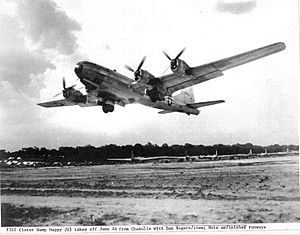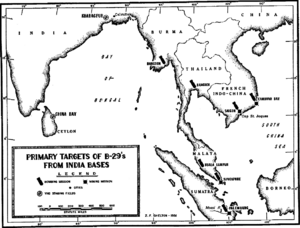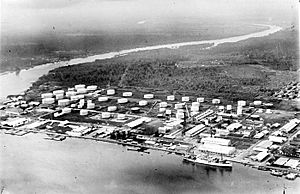Operation Boomerang facts for kids
Quick facts for kids Operation Boomerang |
|||||||
|---|---|---|---|---|---|---|---|
| Part of the Pacific War, World War II | |||||||
 A XX Bomber Command B-29 Superfortress taking off from an airfield in India during June 1944 |
|||||||
|
|||||||
| Belligerents | |||||||
| Units involved | |||||||
| XX Bomber Command Eastern Fleet |
Palembang Defense Unit | ||||||
| Strength | |||||||
| 54 aircraft dispatched 39 reached Palembang |
Antiaircraft guns Fighter aircraft |
||||||
| Casualties and losses | |||||||
| One aircraft One killed |
One building destroyed Three ships sunk, four damaged |
||||||
Operation Boomerang was an air raid during World War II by the United States Army Air Forces (USAAF). It happened on the night of August 10-11, 1944. The goal was to attack oil factories in Palembang, a city in the Dutch East Indies (which is now Indonesia). At that time, Japan controlled Palembang.
The attack was part of a bigger plan by the USAAF's XX Bomber Command. Their main job was to bomb targets in Japan. But they also attacked other Japanese-held cities in Southeast Asia. On the same night as Operation Boomerang, they also bombed the Japanese city of Nagasaki.
Fifty-four B-29 Superfortress planes took off from an airfield in British Ceylon (now Sri Lanka). Thirty-nine of these planes reached the Palembang area. The bombing of the oil factory wasn't very successful; only one building was confirmed destroyed. However, planes also dropped mines into the Musi River. These mines sank three ships and damaged four others. British air and navy forces helped by being ready to rescue any American planes that might crash.
Japanese anti-aircraft guns and fighter planes defending Palembang didn't shoot down any American bombers. But one B-29 ran out of fuel and had to land in the water. This was the only time the USAAF attacked Palembang's important oil facilities. British planes from aircraft carriers attacked these oil sites again in January 1945.
Contents
Why Palembang Was Important
During the Pacific War, Palembang was a very important place for oil. It is located on the island of Sumatra in the Dutch East Indies. Japanese forces captured the city and its oil factories in February 1942 during the Battle of Palembang. Dutch engineers tried to destroy the oil factories so the Japanese couldn't use them. But the Japanese managed to get them working again by the end of 1942.
By early 1944, Allied spies believed that the Pladjoe (Plaju) oil factory in Palembang made a lot of Japan's fuel. It was thought to produce 22 percent of Japan's ship and factory fuel, and 78 percent of its aviation gasoline (fuel for planes). This made Palembang a key target for the Allies.
In late 1943, the United States military leaders decided to start bombing Japan and East Asia. They planned to use B-29 Superfortress bombers. These planes would be based in India and fly from temporary airfields in China. This plan was called Operation Matterhorn. The main idea was to build airstrips near Chengdu in China. B-29s would fly from India to China, refuel, and then fly to targets in Japan.
The Twentieth Air Force was in charge of Operation Matterhorn. General Henry H. Arnold, the head of the USAAF, directly commanded this force. He wanted it to be a strong bombing group. Brigadier General Kenneth Wolfe led the XX Bomber Command. Their first combat mission was against Bangkok on June 5, 1944. During that mission, two B-29s ran out of fuel and had to land in the Bay of Bengal.
Planning the Attack
The idea to attack Palembang came from discussions about how to use the B-29s. In late 1943 and early 1944, some thought the B-29s should first attack Japanese ships and oil sites in Southeast Asia. These attacks would launch from bases in northern Australia and New Guinea.
However, the final plan for Operation Matterhorn said that the XX Bomber Command should focus on Japan. But it also said they should attack Palembang. These raids would start from airfields in British Ceylon. Including Palembang was a compromise. It satisfied those who wanted to bomb Japan and those who wanted to target oil. The first attack on Palembang was planned for July 20, 1944.
Workers in Ceylon began preparing airfields for the B-29s in March 1944. RAF China Bay and RAF Minneriya were the top priorities. They were supposed to be ready by July. But it became clear that only China Bay could be finished in time. By mid-July, China Bay could hold 56 B-29s. It was fully ready when Operation Boomerang happened.
After the XX Bomber Command's first attack on Japan in June 1944, General Arnold wanted Wolfe to attack Palembang. Wolfe said it wouldn't be possible until July 15, when China Bay was ready. On June 27, Arnold ordered 50 B-29s to attack Palembang as soon as the airfield was complete. Wolfe was moved to a new role on July 4. Brigadier General LaVern G. Saunders took over temporarily. Saunders decided to wait until mid-August for the Palembang attack. He wanted the XX Bomber Command to first make a big attack on Anshan in China, which Arnold thought was more important.
Preparing for the Mission
Planning for the Palembang attack started in May 1944. It was a very long flight, so it needed more planning than other XX Bomber Command missions. American and British Royal Air Force (RAF) teams worked together. The British provided fuel and paid for the airfield upgrades in Ceylon. RAF China Bay was mostly given to the USAAF. The RAF even gave whiskey to the Americans!
The plans changed over time. At first, the Twentieth Air Force wanted all 112 B-29s to attack during the day. But the command argued that so many planes from one airfield would need to fly in waves. This would make the mission harder and likely cause more losses. Arnold agreed. His June 27 order said the attack should happen at dawn or dusk. Then, a weather expert suggested attacking at night. This would let the B-29s use helpful tailwinds. The XX Bomber Command got approval for this change.
During planning, some US intelligence groups changed their minds about Palembang's importance. They thought that with changes in the war and Japanese shipping losses, the Pladjoe factory wasn't as critical. XX Bomber Command staff wanted to cancel the mission. They saw it as a distraction from bombing Japan's steel industry. But the military leaders still wanted Palembang attacked. Arnold included it in another target list in July. Once China Bay was confirmed ready by August 4, Arnold ordered the raid by August 15. The attack date was set for August 10.
Several targets were chosen. The main target was the Pladjoe factory. The Pangkalan factory nearby was the second choice. The Indarung Cement Plant at Padang was a last resort if planes couldn't reach Palembang. Some planes were also told to drop naval mines into the Musi River. All the oil from Palembang was shipped through this river.
Because the flight from Ceylon to Palembang and back was so long (about 3,855 miles), the bombers carried only 1 ton of bombs or mines each. Their fuel tanks were filled to the maximum. Planning was finished on August 1. The mission was named Operation Boomerang. Perhaps they hoped all the planes would return from their long journey.
The attack on Nagasaki was planned for the same night as Operation Boomerang. The USAAF hoped that attacking two targets so far apart (3,000 miles) would make a big psychological impact on the Japanese.
Japanese Defenses
The Imperial Japanese Army was in charge of defending Sumatra's oil fields from air attacks. The Palembang Air Defense Headquarters was set up in March 1943. It had three air defense regiments, each with twenty 75 mm anti-aircraft guns. They also had machine cannon batteries and searchlight batteries.
In January 1944, the 9th Air Division was formed to make Sumatra's air defenses stronger. The Palembang Air Defense Headquarters was renamed the Palembang Defense Unit. This unit also got fighter aircraft. The 21st and 22nd Fighter Regiments of the Imperial Japanese Army Air Force were responsible for stopping Allied planes. The defense unit also had barrage balloons, which are large balloons used to block enemy aircraft.
The Attack Begins
On the afternoon of August 9, 56 B-29s arrived at RAF China Bay from India. The planes started taking off from China Bay at 4:45 p.m. on August 10. A total of 54 B-29s were sent out. One plane had engine trouble and returned to base. But it was fixed quickly and took off again for Sumatra.
The flight to Sumatra was smooth. Each plane flew alone, heading straight from China Bay to Siberoet island off Sumatra's west coast. At Siberoet, the bombers changed course and flew towards Palembang. Several British warships and RAF planes were waiting along this route. Their job was to rescue any B-29 crews who had to land in the water. British ships included the cruiser HMS Ceylon and the destroyer Redoubt. Submarines Terrapin and Trenchant were also there, acting as navigation beacons.
Thirty-one B-29s tried to bomb the Pladjoe oil factory. It was hard for the crews to find the target. Palembang had no lights on, and there were patchy clouds. The bomber meant to light up the factory with flares didn't make it there. So, the bombardiers aimed their bombs using radar or by looking through gaps in the clouds. American airmen saw some explosions and fires, but photos taken from the planes were unclear. Eight B-29s flew lower to drop two mines each into the Musi River. This part of the attack was very accurate. This was the first time B-29s were used to lay mines.
Fifteen B-29s didn't reach the Palembang area. Three of them attacked other targets. Two B-29s bombed the oil town of Pangkalanbrandan in northern Sumatra. Another hit an airfield near Djambi. Several bombers had to turn back because they were running low on fuel.
Japanese forces tried to attack the B-29s over Palembang, but they failed. Anti-aircraft guns and rockets were fired. American airmen saw 37 Japanese planes. Some fighters chased the bombers for 350 miles. But none of the B-29s were damaged.
One B-29 ran out of fuel on its way back and landed in the sea about 90 miles from China Bay. Its crew sent an SOS signal before ditching. Allied forces searched the area. One of the bomber's gunners died, but the rest of the crew were rescued on August 12. The Allies had expected more planes to ditch due to fuel shortages, but this was the only loss. The mission lasted about 19 hours. The mining of the Musi River is considered the longest combat mission of the war.
The attack on Nagasaki, which happened at the same time as Operation Boomerang, was not successful. Twenty-four B-29s bombed the city, but little damage was done. Two other bombers turned back, and three attacked other targets. All the B-29s returned safely to their bases.
After the Attack
Operation Boomerang had mixed results. Photos of the Pladjoe factory taken on September 19 showed that only one building was definitely destroyed. A few others were probably damaged. However, the mine-laying part of the attack was successful. Three ships (totaling 1,768 tons) were sunk, and four others were damaged. The Japanese couldn't transport oil on the Musi River for a month until they cleared the mines. After this, B-29s often laid mines to help block Japan. Even though Operation Boomerang didn't fully reach its goals, it showed that the XX Bomber Command could do complex missions. It also proved that B-29s could fly long distances safely over water.
The XX Bomber Command thought Operation Boomerang was unsuccessful based on photos taken after the attack. They didn't want to attack Palembang again. On August 24, they suggested to the Twentieth Air Force that they stop using the facilities at China Bay. This was approved on October 3, though the fuel system for planes was kept. No other B-29 attacks were launched from Ceylon. The USAAF's official history said that upgrading the base for just one mission was "a glaring example of the extravagance of war." The XX Bomber Command attacked several other cities in Southeast Asia in 1944 and early 1945. These included many raids on Japanese-occupied Singapore, which needed even longer flights than those to Palembang.
British aircraft carriers from the Eastern Fleet attacked oil facilities in Sumatra several times between November 1944 and January 1945. This included two attacks on Palembang as part of Operation Meridian in January 1945. On January 24, British planes badly damaged the Pladjoe factory. On January 29, they seriously damaged the nearby Sungai Gerong factory. After the war, the Japanese general who commanded the oil factories at Palembang said these British attacks caused much more damage than Operation Boomerang.




